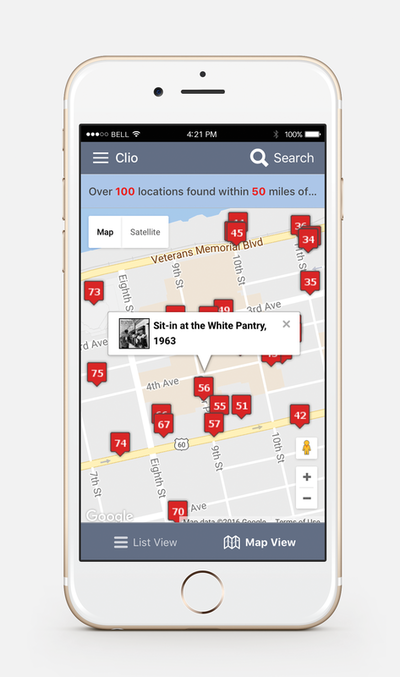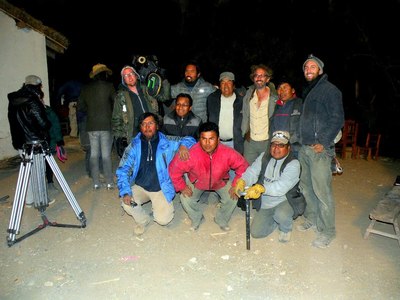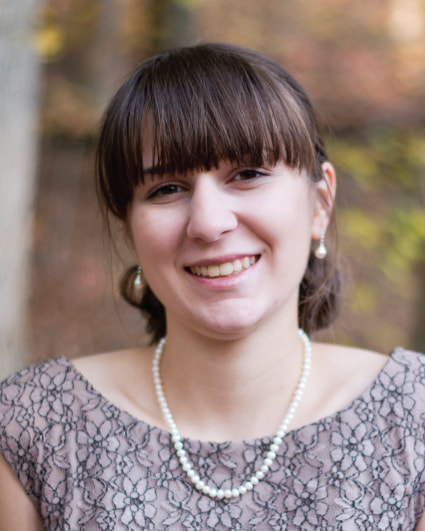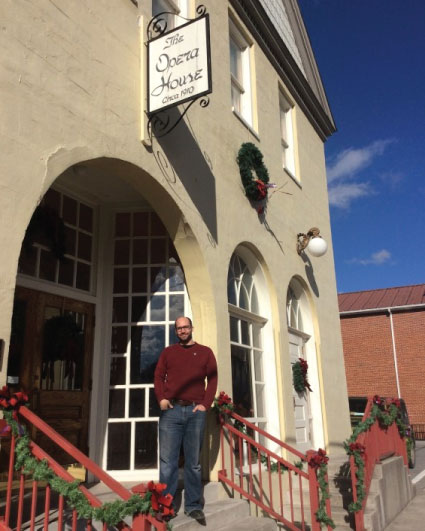 My name is Kara Gordon and I am a Preserve WV AmeriCorps Member at the Cockayne Farmstead in Glen Dale, WV. Since I am originally from Wheeling, WV, I love that I get to help preserve the history of my own local area. So far, I have stayed relatively local pretty much my whole life, graduating with a bachelor’s degree in history from Wheeling Jesuit University and a master’s degree in history from West Virginia University. While in school, I also worked, volunteered, or interned at several museums and archives, including the Archives of the Diocese of Wheeling-Charleston, the Mansion Museum at Oglebay Institute, and the West Virginia and Regional History Center. I love studying everyday history in many forms, but I am especially interested in material culture, and most especially, clothing and textiles. In the summer of 2017, I got the opportunity to intern at Colonial Williamsburg in the Margaret Hunter Millinery Shop and it was truly a dream come true! I love to sew and recreating historical garments has been a favorite hobby of mine for many years. When you try on the clothing worn by people from another time – literally stepping into their shoes – I feel like that connection to the past becomes even more real. Cockayne Farmstead is a bit of a diamond in the rough in many ways. The house itself is rough inside, since it has been preserved but not restored, left as it was found by its last, reclusive owner. Sometimes the “shabby” appearance shocks visitors at first, but it is a glimpse into the passage of time that simply takes a little bit of time to appreciate. Like so many small, volunteer-led historic sites, the house only exists at all because of passionate, dedicated individuals working with very limited resources. This is the story for so many small sites in West Virginia and across the country, and serving with AmeriCorps allows me to help preserve this important local resource. Though its smallness may seem like a disadvantage to some, I look forward to taking on the greater challenges and responsibilities that come with working in a place where my ideas and actions can truly make a difference, instead of being lost in the crowd. It’s a place and a story you can truly become attached to, and I look forward to serving here for the coming year.  Architecture, at its best, creates an environment that is both functional and beautiful. In a world devoid of any concern for aesthetics, we lose our ability to revel in the beauty that surrounds us, confounds us, and inspires us. I spend a lot of my time looking up and around, enjoying the built and natural environment. This is how I’ve come to know that Wheeling, WV is the right place for me. If you’ve never visited Wheeling, you’re missing out on an architectural gem. Throughout my time in the Friendly City, I have never lived in any building younger than 100 years old. My name is Kellie White, and I am a historic preservationist in training. I am originally from Virginia Beach, VA. I moved to Fairfax, VA in 2012 to pursue my undergraduate degree at George Mason University. I completed my BA in Art History and Anthropology with a minor in Women and Gender Studies in 2016. After I graduated, in the Fall of 2016, I decided to move to Wheeling and attend Belmont College to study Building Preservation. Except I didn’t always want to study historic preservation; it took me a while to reach that decision! During middle and high school I was a dedicated musician, and I wholeheartedly believed I would study music. And yet I entered college as an Environmental Studies major. In retrospect, I see that I started down this path in high school. Mrs. Reich’s AP Art History was the most influential class I took in high school; it eventually lead me to study a combination of Art History and Anthropology in college. And Art History lead to the greatest summer of my life. During the summer of 2014, I was offered to opportunity to study archaeology and preservation at George Washington’s Mt. Vernon. I spent that time smeared in dirt and happier than I could have imagined. There’s something mesmerizing about interacting with history in such a gritty, substantial way. That summer was decisive in determining the path I have traveled for the past 2 years. That summer is when I learned about Belmont College and its hands-on Building Preservation program; it planted the seed for where I am now. In my current Plaster course, I am learning to “run” a cornice and cast the decorative elements in plaster. I currently attend Belmont College studying Building Preservation, and I am immersed in the Wheeling community. I am a board member of the Wheeling Young Preservationist, a group of like-minded individuals who take stock of preservation activities and needs within our community. I am also a member of the Wheeling Arts and Cultural Commision; we help encourage creativity in Wheeling. I take pride in my community, in our community. I want to see tangible change in Wheeling, in the whole of West Virginia. This is why I’ve chosen to serve as the Americorps member for the West Virginia Association of Museums. By preserving and educating others about our communal heritage, I hope to help us all recognize the humanity we share. Museums are a space to explore this cultural inheritance.. Standing in a museum, examining a display, for a moment we are sharing an experience. We are all being presented the same information, being confronted with the same truths, being shown our heritage and history. Have you ever experienced wonder or delight in a museum, standing in front of a painting, a historic flag, or a suit of armor? I have. I hope that feeling never fades. Through my service at the West Virginia Association of Museums, I aim to encourage people to visit museums, to experience that wonder, and to bond over our communal heritage.  My name is Alanna Natanson, and I am excited to be the 2018-2019 Preserve WV AmeriCorps member serving at the West Virginia and Regional History Center at West Virginia University in Morgantown, West Virginia. While engaging with a collection related to historic structures in the Mountain State, I hope to understand how the natural environment and built landscape affected the lives of people in West Virginia across the 19th and 20th centuries. I know those histories still influence the state I can’t wait to explore today. From the age of five, all my family road trips from our home in the suburbs of Washington D.C. involved visits to historical landmarks and museums. While we worked our way across centuries and up and down the East Coast, I developed a deep passion for learning about U.S. history, both its proudest moments and its most terrible. After an internship in high school with Historic Takoma Inc. researching hometown heroes of World War II through yearbooks and census records, I realized the behind-the-scenes stories of telling history fascinated me even more than the history itself. I love knowing how archives make materials accessible to historians, and how the limits of collections at historical institutions ultimately shape the arguments a researcher can create. By the end of my first year of college, I knew I wanted to pursue a career making historical collections available to researchers.
I’ve been lucky enough to explore my interest in archives while processing collections in all kinds of research institutions: the Stetten Museum of Medical Research at the National Institutes of Health in Bethesda, Maryland, the Forsyth County Public Library’s North Carolina Room in Winston Salem, North Carolina, the Salem College Library and Archives also in Winston Salem, and the Kentucky Historical Society in Frankfort, Kentucky. Now, I’m excited to apply all my experiences while processing the Emory Kemp Collection at the West Virginia and Regional History Center. Emory Kemp founded the Institute for the History of Technology and Industrial Archaeology at West Virginia University while also serving as a faculty member in the School of Engineering and College of Arts and Science. His collection not only documents his own life, but also records key information about many of West Virginia and Appalachia’s oldest bridges, canals, dams and man-made waterways. After we make his collection available to the public, scholars will have the opportunity to understand the way past West Virginians honed the natural terrain to build transportation and industry in the state. For me, the project is going to be a wonderful way to learn about West Virginia (a trip to Harper’s Ferry made up the whole of my West Virginia experience prior to Preserve WV AmeriCorps). Not only do I look forward to scouring through photographs and blueprints of West Virginia’s structures; I also want to pay attention to how these industrial remnants tell stories about the labor, politics and daily life of generations of West Virginians. Buildings are the physical manifestations of people, and this collection houses the stories of a wide range of humans embedded among the state’s bricks and steel. Digging up those stories is going to bring out characters who show sides of West Virginia the world may not yet know. I chose to serve with Preserve WV AmeriCorps because I want to use my love of behind-the-scenes history to feature stories that don’t usually appear in historical scholarship. This year, I also want to learn to shape a high-quality historical picture of West Virginia while leaving my biases out of the collection as much as possible. Preserve WV AmeriCorps will help me grow, just as I hope that I can facilitate a small part of the history of the preservation movement in West Virginia.
My name is Kiersten White, and I am serving as a Preserve WV AmeriCorps member with Carnegie Hall in Lewisburg, WV. I was raised in Preston County, a place ingrained with my family roots. Growing up, I spent a lot of time outdoors, reading, and exploring the Smithsonian with my family. I was very involved in my high school’s marching band, choir, and theatre program. After graduation, I toured and performed in six European countries with the Sound of America Honor Chorus and Band. Afterwards, I attended Berea College in Berea, KY for two years and then received my Bachelor of Arts in Theatre from Millikin University in Illinois. During college, I was once again able to sing abroad in Spain and Portugal. Throughout my travels, my love and passion for history and embracing the world around me has grown significantly.
During my senior year of college, I was unsure of what path I wanted to take with my degree. My cousin suggested applying for AmeriCorps as she had spent a few years serving. Because of her suggestion, I spent the last year serving as an AmeriCorps VISTA at Frontier Nursing University in Kentucky. While there, I worked with a summer service learning program and created projects and events around the concept of healthy futures. Near the end of my service year, I felt West Virginia calling me back home. I wanted to find a position where I could work in theatre but also embrace my other passions. Thankfully, I stumbled upon the Preserve WV AmeriCorps positions and found just what I was looking for. During my year at Carnegie Hall, I will be working on archiving, developing a script for tours, gathering stories, and many other tasks. I have not had a lot of opportunity to travel the southern part of the state and look forward to immersing myself in its unique qualities and people. Here’s to a new adventure!
I am from Latrobe, Pennsylvania, and share a hometown with children’s television educator Fred Rogers, professional golfer Arnold Palmer, and even the first banana split. History, therefore, was an ever-present and meaningful part of growing up. I soon realized there were so many stories from the past left unwritten. When I attended Saint Vincent College for history, I wrote my senior thesis on Powdermill Nature Reserve’s bird banding lab, the longest continually-running station of its kind in the United States. Having visited and worked at Powdermill for many years, I was excited to document its history and craft an interesting narrative. I also developed an exhibit on Rachel Carson at the McCarl Coverlet Gallery on campus. Thanks to these projects and my academic mentors at Saint Vincent, I discovered the worlds of public history and environmental history. At West Virginia University, I worked with professors and fellow graduate students on public history projects such as the West Virginia glass industry and Jack Roberts Park. A project on Morgantown’s Sunnyside neighborhood soon developed into my MA thesis, which looked at changes in the neighborhood’s culture, housing, and approach to development. In the summer of 2016, I had the wonderful opportunity to intern at the Smithsonian’s National Air and Space Museum on the National Mall in Washington, D.C., where I worked on education programs, exhibit development, and book projects. Furthermore, I spent a few weeks of this summer traveling Europe with my sister and witnessing an incredible array of historic sites, cultures, and stories. Whether I was spending time in the mountains of Pennsylvania and West Virginia, working on “America’s Front Yard” in the country’s most-visited museum, or traveling the world, I have learned a lot about the power of place. My studies over the past few years have solidified a passion for cultural landscapes and understanding sense of place and identity. Clio turns the physical, ever-changing landscapes of our world into a virtual museum, where we can document and discover the past around us. There are currently around 30,000 Clio entries on historical sites, museums, monuments, landmarks, and other sites of cultural or historical significance. One of my favorite features of Clio is the Time Capsule category, which encourages users to create entries for sites that no longer exist. Each Clio entry includes a concise, scholarly narrative and informative resources such as photographs, maps, primary sources, books, articles, videos, and credible websites. These entries are created by individuals, organizations, teachers, and students, building not only a collection of entries but a community of engaged users. I first learned about Clio and the Preserve WV AmeriCorps program through my colleagues at WVU. I heard nothing but accolades, which motivated me to pursue AmeriCorps after graduation. I am thrilled to serve with a nonprofit that is promoting historical scholarship and community engagement on a creative digital platform. I also appreciate the philosophy of its founder, Dr. David Trowbridge of Marshall University, that success is not measured by clicks or downloads but by interaction with historical and cultural resources. This commitment to education and public accessibility gives so much meaning to my everyday work.
A northern California native, Kyle Warmack has had a passion for history all his life. This love of history led him to work in the film industry, first in receiving his education at the UCLA School of Film, Theater and Television, then for ten years as gaffer (Chief Lighting Technician) on a wide range of screen projects. Kyle first fell in love with the history of West Virginia while working in the state on two feature films several years ago. When he was looking for an opportunity to give back through service in 2017, the positions offered by the Preservation Alliance proved to be an ideal chance to spend more time learning about the Mountain State's rich past while contributing to this unique and special place. While serving as a Preserve WV AmeriCorps member with the Clio Foundation, he has the excuse to talk about history with anyone and everyone in the state...and he's going to try to do just that!
My name is Rebekah Valentine. I am currently serving as a Preserve WV AmeriCorps member at the Waldomore, which is affiliated with the Clarksburg/Harrison County Public Library. During my service year, I will organize and inventory artifacts, create an exhibit, assist with tours, and recruit and train volunteers.
My name is Elizabeth Satterfield, and I am serving with the West Virginia Association of Museums. I am studying history at West Virginia University, with emphases in historic preservation and West Virginia history. Currently, I am researching Swiss settlement in Randolph County, WV, for my senior capstone in addition to creating an exhibit for WVU’s library based on summer research on the Sunnyside neighborhood of Morgantown
When I heard about Preserve WV AmeriCorps positions in Morgantown, I quickly applied, hoping to expand my experience and network within the preservation field. I accepted a position with the West Virginia Association of Museums to learn more about the administrative side of museums, how to write grants, and improve my event planning skills. I am also excited to contribute to a stronger museum community within the state through educational workshops and accessible resources. I am looking forward to meeting many new people through the Preserve WV program and participating in service projects across the state.
|
Preserve WV StoriesCategories
All
Archives
August 2023
|
Get Involved |
Programs |
Contact UsPreservation Alliance of West Virginia
421 Davis Avenue, #4 | Elkins, WV 26241 Email: [email protected] Phone: 304-345-6005 |
Organizational Partners:
© COPYRIGHT 2022 - PRESERVATION ALLIANCE OF WEST VIRGINIA. ALL RIGHTS RESERVED.













 RSS Feed
RSS Feed



